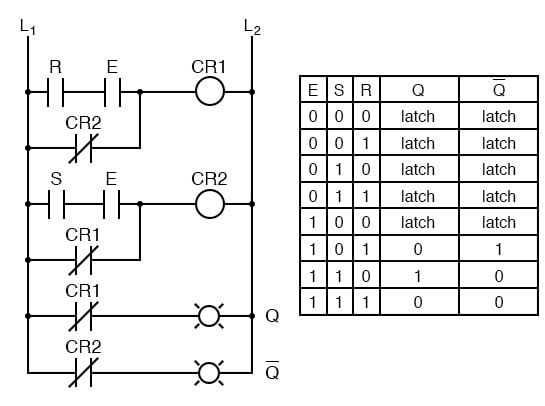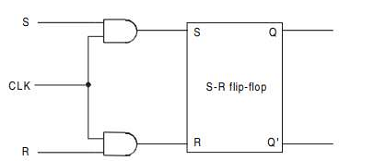S R Latch Notes

The S-R latch can be constructed by using either two NAND or two NOR Gates. When two cross coupled NOR Gates as shown in the figure 1 used then the resultant is the S-R Latch.
In digital electronics, a Latch is one kind of a logic circuit, and it is also known as a bistable-multivibrator. Because it has two stable states namely active high as well as active low. It works like a storage device by holding the data through a feedback lane. It stores 1-bit of data as long as the apparatus is activated. Once enable is declared then instantly latch can change the stored data. It constantly trials the inputs once enable signal is activated. The working of these circuits can be done in 2-states based on the enable signal being high or else low. When the latch circuit is the in an active high state, then both the i/ps are low. Similarly, when the latch circuit is then an active low state, then both the i/ps are high.
- As Trevor shared the image in the comment, S-R latch contains NOR gates. In the first timing diagram, when S becomes 1, after 10ns QN becomes 0, and 10ns later Q becomes 1. Now, draw the S-R latch with NOR gates, write initial values near corresponding letters (S=0, R=0, Q=0, QN=1), change S to 1, and try to understand what changes you see.
- When using static gates as building blocks, the most fundamental latch is the simple SR latch, where S and R stand for set and reset. It can be constructed from a pair of cross-coupled NOR or NAND logic gates. The stored bit is present on the output marked Q. The circuit shown below is a basic NAND latch.
Different Types of Latches
The latches can be classified into different types which include SR Latch, Gated S-R Latch, D latch, Gated D Latch, JK Latch, and T Latch.
SR Latch
An SR (Set/Reset) latch is an asynchronous apparatus, and it works separately for control signals by depending on the S-state & R-inputs. The SR-latch using 2-NOR gates with a cross loop connection is exhibited below. These latches can be built with NAND gates also; however, the two inputs are exchanged as well as canceled. So it is called as SR’-latch.
Whenever a high input is given to the S-line of the latch, then the output Q goes high. In the feedback process, the output Q will stay high, when the S-input goes low once more. In this way, the latch works as a memory device.
Equally, a high input is given to the R-line of the latch, then the Q output goes low (and Q’ high), then the memory of the latch will effectively reset. When both the inputs of the latch are low, then it stays in its earlier set state or reset state. The state transition table or truth table of SR latch is shown below.
| S | R | Q | Q’ |
| 0 | 0 | Latch | Latch |
0 | 1 | 0 | 1 |
| 1 | 0 | 1 | 0 |
1 | 1 | 0 | 0 |
When both inputs are high at once, there is trouble: it is being told toward concurrently generating a high Q & low Q. This generates a race condition in the circuit either flip flop achieves something in altering first will respond to the other & declares itself. Preferably, both Logic gates are equal and the device will be in an undefined condition for an indefinite stage.
Gated SR Latch
Sr Latch Notes Meaning
In some cases, it may be popular to order when the latch can & cannot latch. The simple extension of an SR latch is nothing but a gated SR latch. It gives an Enable line that should be driven high before information can be latched. Although a control line is necessary, the latch is not synchronous due to the inputs which can alter the output even in the middle of an enable pulse.
When the input of an Enable is low, the o/ps from the gates must also be less, therefore the Q & Q outputs stay latched toward the earlier information. Simply when the enable i/p is high can change the position of the latch, as shown in the tabular form. As the enable line is stated, a gated SR-latch is equal in the process toward an SR latch. Sometimes, an enable line is a CLK signal; however, it is a read/write strobe.
CLK | S | R | Q(t+1) |
0 | X | X | Q(t) (no change) |
| 1 | 0 | 0 | Q(t) (no change) |
1 | 0 | 1 | 0 |
| 1 | 1 | 0 | 1 |
1 | 1 | 1 | X |
D Latch
The data latch is an easy expansion to the gated SR-latch that eliminates the chance of unacceptable states of input. Because the gated SR latch lets us fastener the output without employing the inputs of S or R, we can eliminate one of the i/ps by driving both the inputs with an opposite driver. We eliminate one input & automatically make it opposite of the residual input.
The D-latch outputs the input of the D when the Enable line is high, otherwise, the output is whatever the D input was whenever the Enable input was last high. This is the reason it is known as a transparent latch. When Enable is stated, then the latch is called as transparent and signals spread straightly through it since if it isn’t present.
E | D | Q | Q’ |
0 | 0 | Latch | Latch |
0 | 1 | Latch | Latch |
1 | 0 | 0 | 1 |
| 1 | 1 | 1 | 0 |
Gated D Latch
A gated D latch is designed simply by changing a gated SR-latch, and the only change in the gated SR-latch is that the input R must be modified to inverted S. Gated latch cannot be formed from SR-latch using NOR is shown below.
Whenever the CLK otherwise enable is high, the o/p latches anything is on the input of the D. Similarly when the CLK is low, then the D i/p for the final enable high is the output.
CLK | D | Q(t+1) |
| 0 | X | Q(t) |
1 | 0 | 0 |
| 1 | 1 | 1 |
The circuit of the latch will not at all experience a Race state due to the only D input is reversed to offer to both the inputs. Therefore, there is no possibility for similar input state. Thus the circuit of D-latch can be securely used in several circuits.
JK Latch
The both JK latch, as well as RS latch, is similar. This latch comprises two inputs namely J and K which are shown in the following logic gate diagram. In this type of latch, the unclear state has been removed here. When the JK latch inputs are high, the output will be toggled. The only difference we can observe here is the output feedback toward inputs, which is not present in the RS-latch.
T Latch
The T latch can be formed whenever the JK latch inputs are shorted. The function of T Latch will be like this when the input of the latch is high, and then the output will be toggled.

Advantages of Latches
The advantages of latches include the following.
- The designing of latches is very flexible when we compare with FFs (flip-flops)
- The latches utilize less power.
- The performance of latch in the design of the high-speed circuit is quick because these are asynchronous within the design and there is no need of CLK signal.
- The shape of the latch is very small and occupies less area
- If the operation of latch based circuit is not finished in a set time, they borrow the necessary time from other to complete the operation
- Latches give aggressive clocking when contrasted with flip-flop circuits.

Disadvantages of Latches
The disadvantages of latches include the following.
Sr Latch Example
- There will be a chance of affecting the race condition, so these are less expected.
- When a latch is level sensitive, then there is a chance of meta-stability.
- Analyzing the circuit is difficult due to the property of level sensitive.
- The circuit can be tested by using an extra CAD program
Application of Latches
The applications of latches include the following.
- Generally, latches are used to keep the conditions of the bits to encode binary numbers
- Latches are single bit storage elements which are widely used in computing as well as data storage.
- Latches are used in the circuits like power gating & clock as a storage device.
- D latches are applicable for asynchronous systems like input or output ports.
- Data latches are used in synchronous two-phase systems for reducing the transit count.
Sr Latch Notes Template
Thus, this is all about an overview of latches. These are the building blocks for sequential circuits. The designing of this can be done using logic gates. Its operation mainly depends on the input of an enable function. Here is a question for you, what are the two working states of latches?